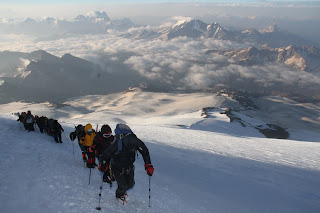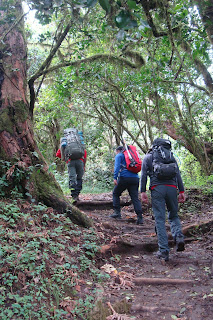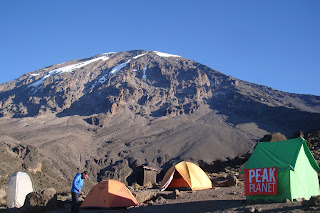Paul Living In Paris
Events, updates and random thoughts while I live in Paris and travel around Europe
Thursday, 18 October 2018
A Few Elbrus Pictures
A few pictures from Elbrus (5,642m) and one photo from the preceding visit to Moscow (July to August 2018).
A Few Kilimanjaro Pictures
A few pictures from Kilimanjaro (November to December 2017) and one photo from the preceding safari.
Sunday, 3 July 2016
Ένα μακρύ Σαββατοκύριακο σε Κύπρος (A Long Weekend in Cyprus)
After visiting 35 countries in Europe, I had reached Cyprus on my to-do list. Many of my former coworkers who had served there in a peacekeeping capacity had told me that it was a beautiful country and worth the visit, but given its location in the eastern Mediterranean, it seemed like a place that I'd be unlikely to visit if I were living in Canada. So this was a good opportunity to go there while in Paris, especially since I was able to find direct flights to and from Larnaca (albeit with awkward scheduling on the return flight).
The downside was that I was going a bit late in the year. By late June, the temperatures are still bearable (around 33ºC) but the humidity was also very high. Due to its eastern location, the island state is more popular with Russian and Czech tourists than Westerners, and I noticed that some of the hotel staff could speak fluent Russian, but English was spoken everywhere I went.
With three days (and a short morning on a fourth day), I travelled to a different city each day.
Paphos
My first day was spent in Paphos, a city on the southwest coast of Cyprus. While travel forums mention that bus service for getting around Cyprus is slow and infrequent, I actually found the bus service to be very efficient (as long as you know the schedule and plan ahead). The public transit intercity bus from Larnaca to Paphos was direct and took a little over two hours (not bad for traversing half the country). Anyways, while Paphos does have a few sandy (but small) beaches in the area, it's better known for its archaeological sites related to Roman, Venetian and Ottoman history.
Nicosia (aka Lefkosia)
I spent the second day of my trip in Nicosia, the capital and largest city of Cyprus. Buses between Larnaca and Nicosia are frequent and only take about 1 hour and 15 minutes. The unique aspect of this city is that it is a divided capital. The southern half of the city is on the Greek side of the UN-administered buffer zone, while the northern half is on the Turkish side. Since there's a border crossing right at the center of the old city, I had the chance to visit both sides.
 |
| The Selimiye Mosque was originally Saint Sophia Cathedral but later converted into a mosque. The interior of the building still has the form of a cathedral, but the mihrab is located off to the side. |
On the Greek side, I visited Saint John's Cathedral, which had a beautiful interior, but photos were not allowed. When I arrived at the Ethnological Museum (at the House of Hadjigeorgakis Kornesios), the museum was 15 minutes from closing so the staff gave me free admission. It turned out that the museum was so small that I was able to see most of it in 10 minutes anyway. It was basically a small mansion in the traditional style of Cyprus, with a few additional displays of Cypriot pottery, woodwork and art.
Ayia Napa
Ayia Napa was a different destination. On the southeast coast of Cyprus, Ayia Napa is known more for its beaches and party atmosphere than for any sightseeing (although there are a few sites there). While the buses to Paphos and Nicosia were only half full (with older tourists), the bus to Ayia Napa was full (with younger tourists) and fortunately I waited at a stop earlier in the route for the return trip because people were being turned away for lack of space. I was a little worried that I'd be heading into festivals of douchebags and woo-girls akin to college spring break in Cancun, but it turns out that Ayia Napa is relatively tranquil and reserved (although I left in the early evening before the clubbing would have started).
 |
| Pantachou Beach is also a popular beach in Ayia Napa, although it has a slightly older crowd. |
 |
| In between Nissi and Pantachou is a small cove where the Vathia Gonia Beach is located. This beach seemed to have younger families, probably due to the calmer waters that the cove provided. |
 |
| Further east of the popular beaches, there are smaller beaches interspersed amongst a rocky coast. There was a wide variety of sightseeing ships and party cruisers that passed by every few minutes. |
Larnaca
I had enough time before my return flight on Monday to check out a few sites near my hotel in Larnaca. It's primarily a beach resort town with a few historical points of interest.
 |
| A view of Finikoudes Beach from the top of Larnaca Castle. The beach is moderately busy during the afternoon and is much quieter than the beaches in Ayia Napa. |
 |
| Saint Lazarus Church. The interior is moderately ornate and decorated like most Greek Orthodox churches. |
So that was Cyprus over three (and a quarter) days. The country felt a bit like a Greek island in that it offered a mix of archaeological sites, sandy beaches and great weather, although it certainly felt like Turkey when I crossed into the northern part of Nicosia. If I had the extra time, I would have also visited Limassol on the south coast or Kyrenia on the north coast, but I think I got a good feel for different parts of the country (well, the Greek side). My next trip is to another southern destination and I'll post more details in about three weeks.
Sunday, 19 June 2016
Een Weekend in Antwerpen en Brugge (A Weekend in Antwerp and Bruges)
Despite the fact that Belgium borders northern France and is only a short train ride away from Paris, I'd only visited the country once on a one-day trip to Brussels. So I spent the first weekend in June visiting Antwerp and Bruges, taking a day in each city. A few coworkers here, as well as a former high school classmate now living in Brussels, recommended Ghent as another interesting travel destination, but Bruges was higher on my priority list and Antwerp looked like it would offer something different from the old towns of Bruges and Ghent. I also lucked out on this trip as the forecast was for scattered showers, but it was sunny, although a bit humid, for most of the weekend (there was often too much glare to take good photos).
Day 1 - Antwerp
I arrived in Antwerp by train at the central station, which is a spacious yet elegantly designed building (although not quite the attraction that travel websites make it out to be). Since I arrived in the late morning, I only had about two thirds of a day to look around, although this was enough given the close proximity of most of the sites. I went straight to the old town, centered by the Cathedral of Our Lady with the Grote Markt to the west. The Stadhuis in Grote Markt contained a small museum on the history of Antwerp which made for a convenient 20 minute visit. There was also a large scavenger hunt competition going on in Antwerp that day, so there were a lot of people running around the area performing various tasks (one guy had to cycle around the statue of Silvius Brabo a countless number of times; I think he may still be there).
The main cathedral in Antwerp has a Gothic exterior and reminded me a lot of the cathedrals of northern France, although Antwerp's cathedral appears to be much taller. The interior was set up as an art museum, although it was still functional for accommodating mass.
The rest of the river bank appeared to be more industrial than cultural, so I headed south to the Plantin-Moretus Museum, only to find that it's under renovation and closed until October (doh!). Instead, I went to the Rubenshuis, the former house and studio of Peter Paul Rubens. The house doubles as an art museum, and also has a small garden that provides a tranquil sanctuary from the bustling shopping area surrounding the building.
Day 2 - Bruges
Bruges is a small city but it's grown in popularity with tourists ever since the movie In Bruges was released. However, Bruges didn't look like what I (vaguely) remember from the movie. It looked greener and more spacious, and while visiting in the summer and focusing on the two main squares in the center and the park areas along the river may have given me a different view, even the narrower streets of the old town didn't resemble the film.
The train station is in the southeast section of the city, so when heading towards the old town, I passed through Sint-Janshospitaalpark as well as by the Site Oud Sint-Jan and the Onze-Lieve-Vrouw church (but did not go inside) before reaching the Markt.
Since the Basiliek van het Heilig Bloed (Basilica of the Holy Blood) was holding mass and too crowded for sightseeing, I took a quick walk to the east side to check out the windmills as well as two of the city gates. (Bruges used to be a walled city and nine of its gates still remain.)
So that was Antwerp and Bruges in a quick weekend. I felt like I could have benefited from an extra half day in Bruges, but I still got a good feel for each city. Both cities are more picturesque than the photos that I've posted here, but the bright sun made photography difficult and there were some places where I just couldn't find the right angle. Antwerp is a modern and very commercial city with an energetic atmosphere, while Bruges is a scenic, laidback town (although a bit touristy).
As you may have also noticed, my trip descriptions are getting shorter and more mundane with each post. Part of this may be from traveling so much that everything is starting to look like a repeat of what I've seen before, but more of this has to do with writing fatigue. For future posts, I might write a short paragraph on each city and leave it to the photos to tell the story. I've got a trip to eastern Europe next weekend, so I'll try to post a summary in two weeks.
Day 1 - Antwerp
I arrived in Antwerp by train at the central station, which is a spacious yet elegantly designed building (although not quite the attraction that travel websites make it out to be). Since I arrived in the late morning, I only had about two thirds of a day to look around, although this was enough given the close proximity of most of the sites. I went straight to the old town, centered by the Cathedral of Our Lady with the Grote Markt to the west. The Stadhuis in Grote Markt contained a small museum on the history of Antwerp which made for a convenient 20 minute visit. There was also a large scavenger hunt competition going on in Antwerp that day, so there were a lot of people running around the area performing various tasks (one guy had to cycle around the statue of Silvius Brabo a countless number of times; I think he may still be there).
 |
| In Grote Markt (Great Market Square), facing west is a view of Antwerp Stadhuis (City Hall) with the statue of Silvius Brabo in front. |
 |
| In Grote Markt, facing east is a view of the square's many guildhalls. |
 |
| On the east bank of the Scheldt river is Hetsteen (Steen Castle). The interior was small and contained a café and a small exhibit on the history of Antwerp. |
Day 2 - Bruges
Bruges is a small city but it's grown in popularity with tourists ever since the movie In Bruges was released. However, Bruges didn't look like what I (vaguely) remember from the movie. It looked greener and more spacious, and while visiting in the summer and focusing on the two main squares in the center and the park areas along the river may have given me a different view, even the narrower streets of the old town didn't resemble the film.
The train station is in the southeast section of the city, so when heading towards the old town, I passed through Sint-Janshospitaalpark as well as by the Site Oud Sint-Jan and the Onze-Lieve-Vrouw church (but did not go inside) before reaching the Markt.
 |
| While there is a small river that encircles most of Bruges, the more scenic waterfront is in the old town along the Gronerei Canal. |
 |
| The Gothic Chamber of the Stadhuis (Town Hall). I'm assuming that's the mayor's chair in which I'm sitting. |
 |
| A photo of Lac D'Amour in Minnewater Park. |
As you may have also noticed, my trip descriptions are getting shorter and more mundane with each post. Part of this may be from traveling so much that everything is starting to look like a repeat of what I've seen before, but more of this has to do with writing fatigue. For future posts, I might write a short paragraph on each city and leave it to the photos to tell the story. I've got a trip to eastern Europe next weekend, so I'll try to post a summary in two weeks.
Subscribe to:
Comments (Atom)










































